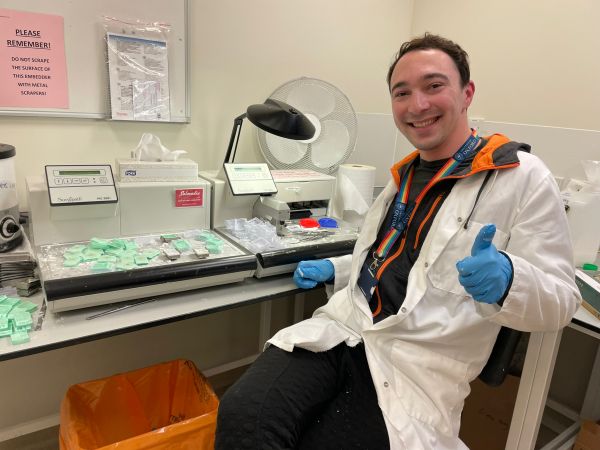Research Update: Molecular determinants of axonal loss in the Multiple Sclerosis spinal cord
Feasibility Study to Determine Biomarkers for MS progression attains Proof of Concept
The MSRTE funded study Molecular determinants of axonal loss in the multiple sclerosis spinal cord, based at John Radcliffe Hospital Department of Neuropathology and Oxford University, has now been completed. This pilot study investigated the feasibility of applying advanced spatial gene expression methods to archived spinal cord pathology samples from people who had Multiple Sclerosis (MS).
It is known that as MS progresses there are an increased number of lesions in the spinal cord. Long-standing inflammation, demyelination of nerve fibres (loss of insulation), and destruction of the actual nerve fibres results in irreversible disability, especially loss of mobility.
In this study the researchers, Alex Waldman and Aimee Avery (pictured below), who are working with Dr. Gabriele De Luca, Professor of Clinical Neurology and Experimental Neuropathology, have been able to demonstrate the feasibility of applying advanced spatial gene expression methods to well-characterised pathology specimens. This is the first stage, and it is hoped that continuing this research may identify potential molecular biomarkers of MS spinal cord pathology. This approach has the potential to give insight into potential mechanisms of disease progression that may be monitored clinically to predict prognosis or serve as targets for future drug therapies.
Progress to Date
Preserved post-mortem spinal cord tissue from 119 MS cases and 17 controls were used in this study, focusing on the cervical (neck) level of the spinal cord, as this area tends to be affected more severely by MS pathology. Lesions, defined as areas of complete demyelination, were identified and classified according to stage of inflammation. At the same time axonal loss, another indicator of disease severity, was quantified using an automated computerised method.
Sixteen cases (three control and thirteen MS) with varying levels of pathology were selected for genetic analysis. Ribonucleic acid (RNA) from these samples was extracted and quality checked before undertaking state of the art gene expression quantification using the 10x Genomics Visium Spatial Transcriptomics platform. Importantly, this experiment has demonstrated proof of concept that spatial transcriptomic approaches can be applied to a unique collection of chemically preserved spinal cord material.
Analysis of this complex data is ongoing and expected to be complete in the final quarter of this year.

Importantly, this experiment has demonstrated proof of concept that spatial transcriptomic approaches can be applied to a unique collection of chemically preserved spinal cord material.
Researcher Alex Waldman [right] said:
“This important research, funded by MSRTE has the potential to unravel the molecular determinants of spinal cord pathology in progressive MS, and identify targets that may be responsive to drugs to halt the accumulation of disability in MS.
"The success of these experiments would not be possible without assistance from MS Research, the University of Oxford Wellcome Centre for Human Genetics and the newly opened Azenta Life Sciences Oxford Genomics Laboratory.”

MSRTE Consultant, Angela Davies-Smith said: “We are extremely excited about the positive implications this study has for revealing new information on MS disease progression. The potential impacts this could have on people living with MS could be life changing, as being able to identify biomarkers for those likely to develop advanced MS could lead to more effective prevention methods for those at risk.”
For more information on this study please read our original announcement.
MS Research is dedicated to furthering ground-breaking research to benefit people living with Multiple Sclerosis. If you are looking for funding for a project or support to attend an MS-related conference, we may be able to help. Please get in touch to find out more.

